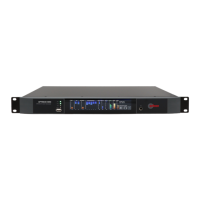Orban 5950 Technical Manual Installation 2-7
Monitoring on Loudspeakers and Headphones
In live operations, highly processed audio often causes a problem with the DJ or presenter’s headphones. When an
“MX” preset is active, the delay through the 5950 can be as much as 270 milliseconds. This delay will be audible as
a distinct echo that almost no one can tolerate in their headphones while speaking. The “Multipath Mitigator”
phase skew corrector adds about 250 ms of delay. The 5950 offers two main solutions to this problem:
x Using a non-MX preset, which provides the same algorithms and performance as THE OPTIMOD-8500.
x Using the 5950’s low-delay “monitor” output to drive talent headphones.
Using the monitor output is appropriate for both HD Radio and non-HD Radio operations, while using a non-MX
preset on-air is only useful in non-HD Radio operations where no diversity delay has been applied to the analog FM
transmission.
Because of their higher performance, we recommend using MX presets in HD Radio operations. In this context, the
preset delay becomes part of the HD Radio diversity delay and the 5950 automatically compensates for the preset
delay to ensure that the diversity delay always agrees with the value you specified when setting the 5950 up.
With non-MX presets, the normal delay through the 5950 (from input to FM outputs) is about 18 ms when HARD
or MEDIUM bass clipping is selected, as it is in all nonMX factory presets other than those with “LL” (“low latency”)
or “UL” (“ultra-low latency”) in their names. An 18 ms delay is workable for most talent (although it may require
some acclimatization) because 18 ms is below the psychoacoustic “echo fusion threshold,” which means that
talent will not hear discrete slap echoes in their headphones. This means that they can monitor comfortably off-air
without being distracted or confused. Moreover, off-air cueing of remote talent is routine.
Some talent moving from an analog processing chain will require a learning period to become accustomed to the
voice coloration caused by “bone-conduction” comb filtering. This is caused by the delayed headphone sound’s
mixing with the live voice sound, which introduces notches in the spectrum that the talent hears when he or she
talks. All digital processors induce this coloration to a greater or lesser extent. Fortunately, it does not cause
confusion or hesitation in the talent’s performance unless the delay is above the psychoacoustic “echo fusion”
(Haas) threshold of approximately 20-25 ms, where the talent starts to hear slap echo in addition to frequency
response colorations.
Two lower-delay options are available. “Low latency” reduces input-to-FM-output delay to 13 ms and “ultra-low
latency” reduces delay to about 3.7 ms. The trade-off for this reduction is approximately 1 dB decrease in loudness
compared to the 5950’s full look-ahead processing for low latency and about 2.5 dB loudness decrease for ultra-
low latency.
x When using a non-MX preset, you can invoke the low latency mode by setting the BASSCLIPMODE control (in
the CLIPPERS page of ADVANCED CONTROL) to LLHARD. You can also recall a preset with “LL” as part of its
name.
LLHARD differs in two ways from the normal HARD mode of the bass clipper:

